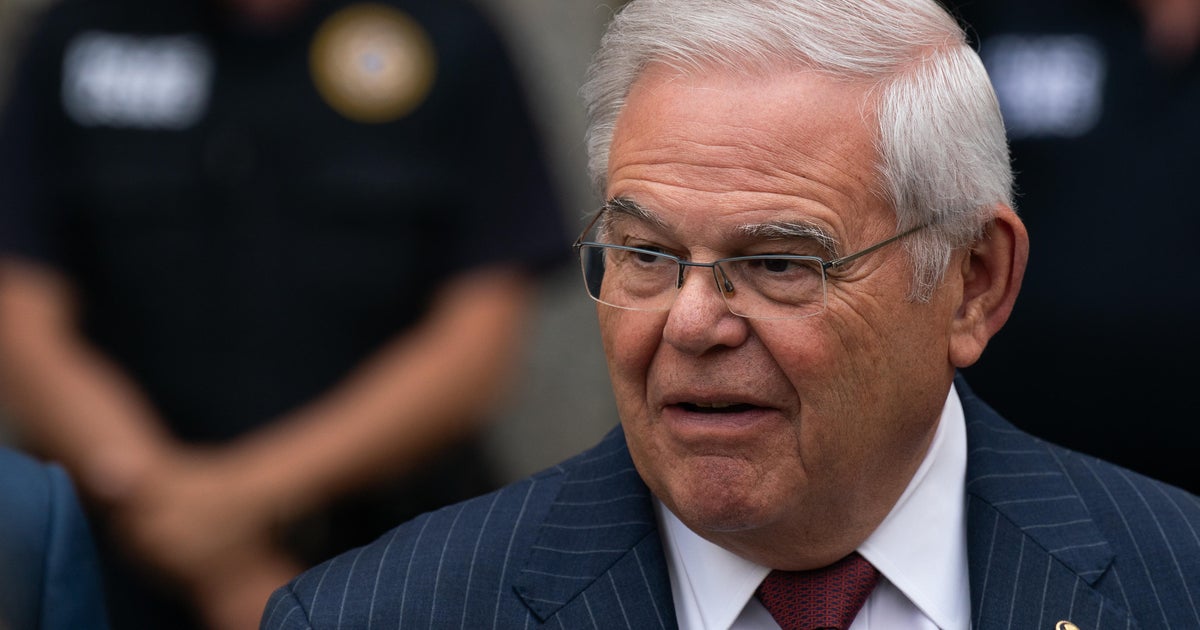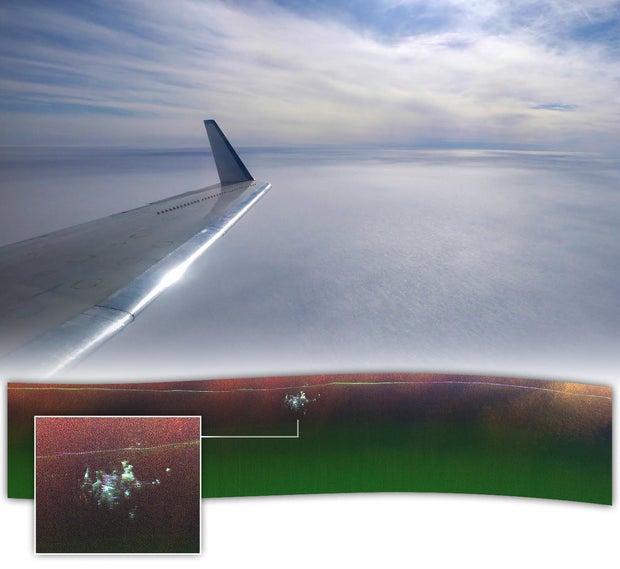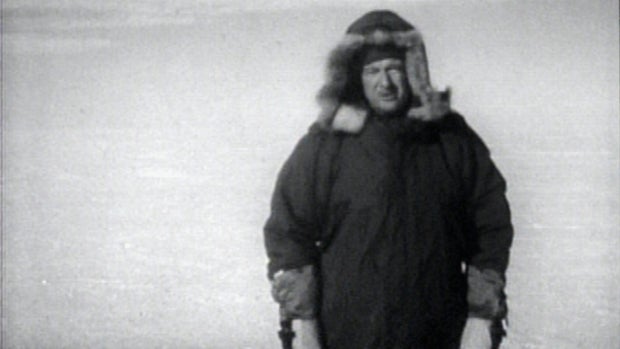CBS News
NASA shows off image “acquired by chance” of U.S. military’s abandoned “city under the ice” in Greenland

As NASA scientist Chad Greene flew over northern Greenland with a team of engineers in April, they never expected their radar to find something manmade buried deep within the ice. Greene and his team were flying above the Greenland Ice Sheet on a NASA Gulfstream III plane, scanning the barren expanse of ice that’s more than a mile deep in some areas, when their radar instrument picked up something unusual.
“We didn’t know what it was at first,” Greene said in a statement released by NASA’s Earth Observatory this week, along with new images of the discovery. “We were looking for the bed of the ice and out pops Camp Century.”
It turns out the team had stumbled upon an abandoned Cold War-era military base built by the U.S. Army Corps of Engineers in 1959. Nicknamed the “city under the ice,” the compound consists of a network of tunnels carved into the ice sheet. It was abandoned in 1967 and, over time, became buried about 100 feet below the surface as snow and ice accumulated.
The base was built as part of Project Iceworm, a then-secret plan to experiment with building a missile launch site under the Greenland Ice Sheet during the Cold War, when tension soared between the U.S. and the then-Soviet Union. Camp Century, a remote, nuclear-powered installation, was built to study the feasibility of such a project, but it was never realized and the base was decommissioned under the assumption it would be buried forever under the ice.
Pictorial Parade/Archive Photos/Getty
While the “city under the ice” had been picked up by previous radar scans, the instruments used on the NASA flight in April provided a more detailed, if unexpected, survey.
“In the new data, individual structures in the secret city are visible in a way that they’ve never been seen before,” said Greene, who works with NASA’s Jet Propulsion Laboratory.
Past scans had used a type of radar that points straight down at the ground and produces a two-dimensional scan of structures buried beneath the ice. Greene’s flight used NASA’s Uninhabited Aerial Vehicle Synthetic Aperture Radar, which is able to produce maps with “more dimensionality,” according to the agency.
A photo released by NASA on Monday showed the features of the base hidden deep under the ice, appearing as anomalies near the base of the ice sheet.
NASA Earth Observatory/Michala Garrison, Jesse Allen, Chad Greene
“Scientists have used maps acquired with conventional radar to corroborate estimates of Camp Century’s depth — part of an effort to estimate when melting and thinning of the ice sheet could re-expose the camp and any remaining biological, chemical, and radioactive waste that was buried along with it,” NASA’s Earth Observatory said in its article this week. “The scientific utility of the new UAVSAR image of Camp Century remains to be seen; for now, it remains a novel curiosity acquired by chance.”
A 2016 study of the abandoned base suggested that the facility could no longer be considered “preserved for eternity,” due to climate change increasing the rate at which Arctic ice is melting.
CBS News’ Walter Cronkite visited Camp Century for a tour of the still-under-construction facility for a program that aired in 1961. The camp’s commander, Captain Tom Evans, explained to him that the goals of the program were three-fold: “The first one is to test out the number of promising new concepts of polar construction. And the second one is to provide a really practical field test of this new nuclear plant. And, finally, we’re building Camp Century to provide a good base, here, in the interior of Greenland, where the scientists can carry on their R&D activities.”
CBS
The exact nature of that research and development work wasn’t discussed in Cronkite’s report for the CBS documentary show “The Twentieth Century.” (An abridged version of that report can be viewed at the link above.)
Speaking with 60 Minutes in 2016, as that show revisited Cronkite’s decades-old trip to Camp Century, producer Daniel Ruetenik said the trip was fascinating, and he marveled at the evolution of human interest in the vast, frozen expanse of the Greenland Ice Sheet.
“At the time [of Camp Century], the Cold War was considered to be the greatest threat to humanity,” Ruetenik said. “And now, the area has become a destination for climate scientists trying to study changes in the environment. So, it has a second purpose now.”
CBS News
Trump tariffs on Canada imports could lead to sharply higher gas prices, experts warn

Americans may be shelling out more for gasoline if the incoming Trump administration follows through on threats to impose tariffs on imports from Canada and Mexico.
President-elect Donald Trump this week said he would enact a 25% tariff on all products from both countries, citing concerns about illegal immigration and illicit drugs flowing into the U.S. While prices could climb on a variety of goods shipped to the U.S., the potential impact on motorists and on the transportation sector could be particularly acute, analysts say.
“Canada and Mexico are huge U.S. trading partners, so it’s a shot across the bow of longtime U.S. allies,” Patrick De Haan, head of petroleum analysis at GasBuddy, told CBS MoneyWatch.
“For a lot of the U.S., it could be problematic for what they pay at the pump,” De Haan said of the tariffs’ impact, in particular to inland regions such as the Great Lakes, Midwest and the Rockies. “The coastal areas have more options — they don’t rely as much on Canadian crude.”
Although the U.S. is the world’s leading oil producer, we still import a lot of crude, with Canada providing roughly 20% of the oil used stateside. As a result, gas prices could shoot up 30 to 40 cents a gallon, and potentially up to 70 cents, within as little as two days after the tariffs take effect, De Haan said.
The national average for a gallon of regular on Wednesday stood at $3.07, down from $3.25 a year ago, according to AAA.
The threatened tariffs on imports from Mexico and Canada could also result in a $3,000 increase in the cost of the average car, according to Wolfe Research analysts cited by the Wall Street Journal. Roughly $97 billion in auto parts are imported to the U.S. from the two nations annually, and 4 million vehicles are shipped in — roughly 3 million from Mexico and 1 million from Canada, the firm estimated.
To be sure, it remains uncertain if Trump will follow through on his trade threats. Some analysts think the president-elect is likely using the specter of tariffs as a way to wring concessions from other countries, noting that his administration will be eager to avoid setting off another round of inflation just as U.S. prices are growing at a normal level.
“We would be surprised if [the tariffs] were ever actually implemented,” analysts with investment adviser Capital Economics wrote in a report, noting that the auto sectors in the Canada, Mexico and the U.S. are tightly interconnected.
CBS News
Macy’s Thanksgiving Day Parade balloons coming to life

Watch CBS News
Be the first to know
Get browser notifications for breaking news, live events, and exclusive reporting.
CBS News
Ex-Sen. Bob Menendez seeks new trial, citing evidence prosecutors said was inadvertently provided to jury

Washington — Former New Jersey Sen. Bob Menendez asked a federal court in New York on Wednesday to throw out his conviction in a sprawling bribery scheme and grant him a new trial after prosecutors disclosed that the jury was inadvertently provided information during deliberations that it should not have been given.
The request from Menendez’s lawyers came in response to a letter prosecutors sent to the court on Nov. 13 revealing they had unintentionally loaded onto a laptop given to the jury during deliberations the incorrect versions of nine exhibits. Prosecutors said neither they nor Menendez’s lawyers, who inspected the exhibits on the laptop, noticed the error at the time.
Government lawyers told U.S. District Judge Sidney Stein that they did not believe the inclusion of the nine exhibits warranted upsetting Menendez’s guilty verdict, in part because “there is no reasonable likelihood any juror ever saw any of the erroneously less-redacted versions.” But Menendez’s lawyers told Stein in a separate filing that the improper disclosure was a “serious breach” by prosecutors and said a new trial was “unavoidable.”
The exhibits, they said, “exposed the jury to a theory of criminality that the government was barred from presenting under the Speech or Debate Clause — namely, that Senator Menendez made specific decisions with respect to military sales to Egypt in exchange for bribes.”
Under the Speech or Debate Clause of the Constitution, senators or House members “shall not be questioned” for “any speech or debate” in either chamber of Congress. Stein had ruled that certain material referencing arms sales and military aid to Egypt were legislative acts shielded by the clause.
Menendez’s defense team said the information disclosed to the jury contained the only evidence that tied him to the provision of military aid to Egypt, which was at the center of the bribery scheme the New Jersey Democrat was accused of engaging in.
They also lambasted prosecutors for attempting to “shift the blame,” calling it “factually and legally outrageous.”
Prosecutors said the court had “expressly prohibited” evidence of past legislative activity, including actions Menendez allegedly took as a senator about foreign aid to Egypt, and said the evidence at issue “squarely crossed that line … and allowed the jury to infer bribery from Senator Menendez’s legislative acts — exactly what the Speech or Debate Clause is meant to prevent.”
Prosecutors claimed that Menendez helped orchestrate a corrupt agreement through which he would work to secretly benefit the Egyptian government in exchange for lavish gifts including cash, gold bars, a Mercedes-Benz convertible, furniture and mortgage payments from three New Jersey businessmen.
He was convicted on 16 felony counts in July, including bribery, fraud and acting as a foreign agent.
Menendez’s two co-defendants in the case, Fred Daibes and Wael Hana, also separately asked the court to grant them new trials and toss out their convictions.
Menendez faced immense pressure to resign after he was indicted on federal bribery charges last year but resisted doing so until he was convicted. He stepped down from the Senate in August, a stunning capstone to a lengthy career in the upper chamber that included a position atop the Senate Foreign Relations Committee.
The former senator is set to be sentenced Jan. 29.












